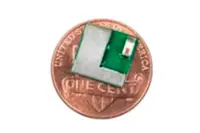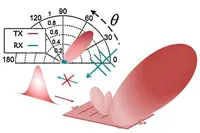Electronics News
Archive : 16 March 2016 год
 A Bluetooth Low Energy module from Cypress is said to extend range to 400m, eight times more than current solutions. Using the EZ-BLE PSoC XT/XR module, the company claims, will open the use of Bluetooth connectivity to a range of home automation, industrial and smart city applications.
A Bluetooth Low Energy module from Cypress is said to extend range to 400m, eight times more than current solutions. Using the EZ-BLE PSoC XT/XR module, the company claims, will open the use of Bluetooth connectivity to a range of home automation, industrial and smart city applications.
The EZ-BLE PSoC XT/XR CYBLE-224110-00 module is supplied in 32pad package measuring 9.5 x 14.5mm and has a temperature range of -40 to 105°C.
Meanwhile, Cypress has also announced the EZ-BLE PRoC CYBLE-222014-01 module, said to be the first to enable the three key features of Bluetooth 4.2 – data length extension, privacy and enhanced security. These, says Cypress, are critical for IoT applications.
Dave Solda, senior director of Cypress’ Module Business Unit, noted: “Our EZ-BLE PSoC XT/XR module, coupled with our upcoming Bluetooth mesh solution, enables customers to develop innovative products that can communicate simultaneously with billions of Bluetooth enabled mobile devices and a wide area Bluetooth network in a cost effective manner.”
The modules integrate an ARM Cortex-M0 core, Cypress’ CapSense capacitive sensing technology, two crystals, an on-board antenna, metal shield and passive components.
Cypress says it has simplified the Bluetooth LE protocol stack and profile configuration into a new royalty free, GUI based BLE Component that can be dragged and dropped into designs using its PSoC Creator integrated design environment.
Author
Graham Pitcher
Source: www.newelectronics.co.uk
 Entries to the British Engineering Excellence Awards – Findlay Media’s celebration of all that’s good about engineering in the UK – are now open.
Entries to the British Engineering Excellence Awards – Findlay Media’s celebration of all that’s good about engineering in the UK – are now open.
Since the British Engineering Excellence Awards – BEEAs – were launched in 2009, the winning entries have ranged in size from chip designs to pipe laying systems, with the Grand Prix – the best of the best – awarded to a kinetic energy recovery system, an engineer who designed a system to save water on a massive scale, a marine communications company and, in 2015, to Oxford Space Systems – a start up company developing deployable space structures. This demonstrates the breadth of the UK’s engineering and innovation capabilities. And every year the quality of entries improves.
The Awards are open to all companies with an engineering design function in the UK. The judging standards are rigorous and the winners will be justifiably proud of their achievement.
Winning companies will be those which recognise that creativity and design innovation are critical elements when it comes to improving and reinvigorating themselves to stay ahead of the competition. Winning engineers will be leading the way in their companies and going that extra mile to promote their profession.
Pic: Mike Lawton, Oxford Space Systems
Author
Graham Pitcher
Source: www.newelectronics.co.uk
 Researchers at The University of Texas at Austin have designed an antenna that can process incoming and outgoing signals more efficiently and without the need for the separate components commonly used. According to the team, its development could lead to faster, cheaper and clearer telecommunications.
Researchers at The University of Texas at Austin have designed an antenna that can process incoming and outgoing signals more efficiently and without the need for the separate components commonly used. According to the team, its development could lead to faster, cheaper and clearer telecommunications.
Their breakthrough is the design of an antenna that can break reciprocity – the natural symmetry in radiation that characterises antennas. By breaking reciprocity, the researchers’ antenna can control incoming and outgoing signals independently with large efficiency.
“Our achievement is that we break the symmetry between transmission and reception signals, so we are able to prevent the antenna from having to listen to reflections and echoes that affect the source,” said Professor Andrea Alù. “We show that it is possible to efficiently overcome these constraints using temporally modulated travelling wave antennas.”
The advantage of this development is the possibility of sending out a signal, while keeping out noise and echoes that come back toward the antenna. This is likely to enable faster data rates and improved connections, while requiring less bulky antenna systems.
Conventional antennas are subject to reciprocity, meaning they transmit and receive signals with the same efficiency; if a conventional antenna is a very good emitter of signals in a certain direction, it is also a very good receiver from the same direction. This property is not always beneficial, says the team, because transmitting antennas are prone to absorb surrounding reflections or echoes, reducing the quality of the transmitted signals.
In its experiments, the team fed the antenna with two signals simultaneously: the RF signal they wanted to transmit or receive; and a weak low frequency modulation signal that slowly changes the properties of the antenna as the RF signal travels along it. This modulation breaks the antenna’s inherent symmetry in transmission and reception.
The researchers are now looking into how this concept may be extended to applications such as optics, believing that by pushing these concepts to higher frequencies, it will be possible to break a similar constraint affecting energy harvesting devices such as thermophotovoltaic cells.
Author
Graham Pitcher
Source: www.newelectronics.co.uk

